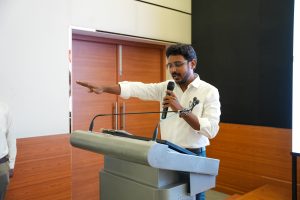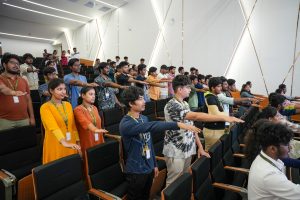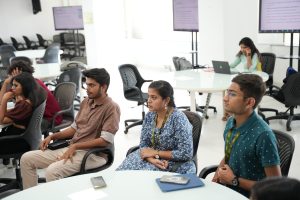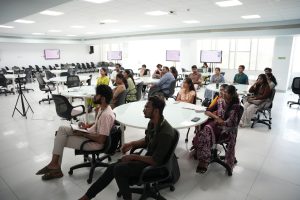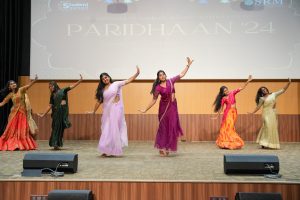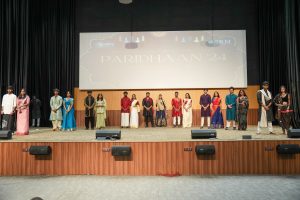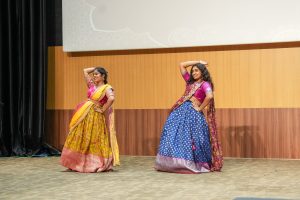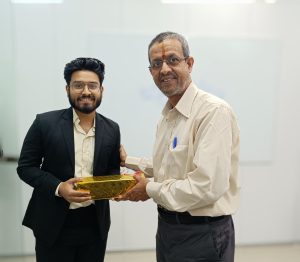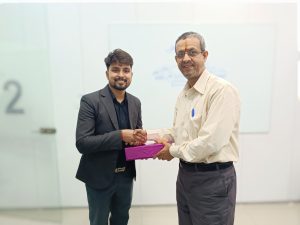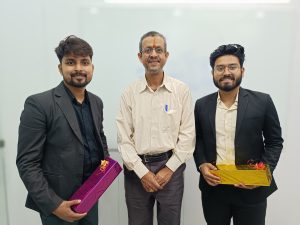#NoExcusesDay: Promoting Voter Awareness and Responsibility
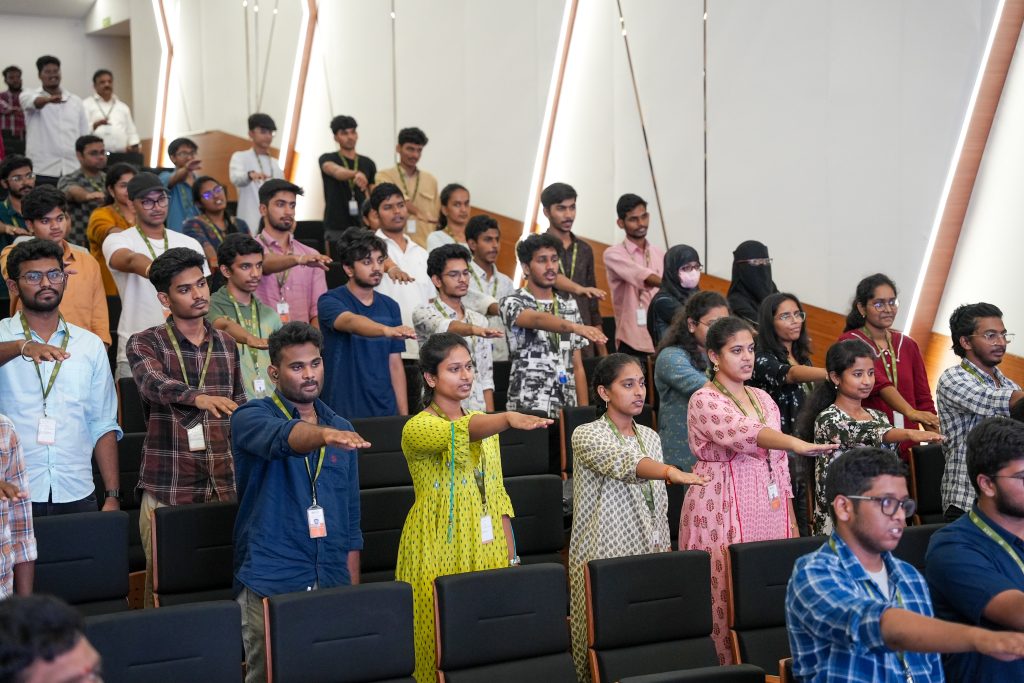
On the auspicious occasion of advocating for voter awareness and responsibility, a “#NoExcusesDay” event was held at SRM University-AP on May 09, 2024, organised by the Times of India and the Directorate of Communications of the university. The event, graced by Chief Guest, Mr Harendhira Prasad, Additional Chief Electoral Officer, aimed to emphasise the significance of voting in a democracy and to motivate citizens, especially the youth, to exercise their right to vote without fail.
The event commenced with the display of a motivating video message from President Draupadi Murmu, setting the tone for the importance of active participation in the electoral process. Highlighting the statistics of voting percentages in assembly elections from Hyderabad, the video presentation was followed by an address by Mr Rajiv Kumar, the Chief Election Commissioner, who underscored the importance of adding 97 crore voters to the electoral rolls.
The introduction of technology in the electoral process was a key point of discussion, with emphasis placed on the utilisation of advanced methods to ensure smooth and efficient polling. The staggering number of 10.5 lakh polling stations across the nation further underscored the magnitude of the electoral process.
Under the theme “Chunav Ka Parv Desh Ka Garv” (Festival of Elections, Pride of the Nation), the event witnessed active participation from students and faculty members alike. Mr Pankaj Belwariar, Director of Communications, and Mr Anil Nigam, Director of Student Affairs, graced the stage to extend their support and encouragement towards fostering a culture of voting. The event also provided a platform for students to share their first-time voting experiences. M. Kartika, Y. Ramya, V. Suma, and Tamineni Harnan Reddy shared their personal anecdotes, underscoring the sense of responsibility and empowerment that comes with casting a vote.
Mr Pankaj Belwariar’s impassioned speech resonated with the audience as he articulated the significance of treating voting as a non-negotiable duty. His “no-excuse day” message struck a chord, urging individuals to overcome obstacles and prioritise their democratic duty. Mr Anil Nigam elaborated on the disparities between rural and urban voting patterns, highlighting the heightened enthusiasm observed in rural areas. Aditya Challa, a fourth-year student, emphasised the symbiotic relationship between voting and the right to question, asserting, “No vote, no right to question.”
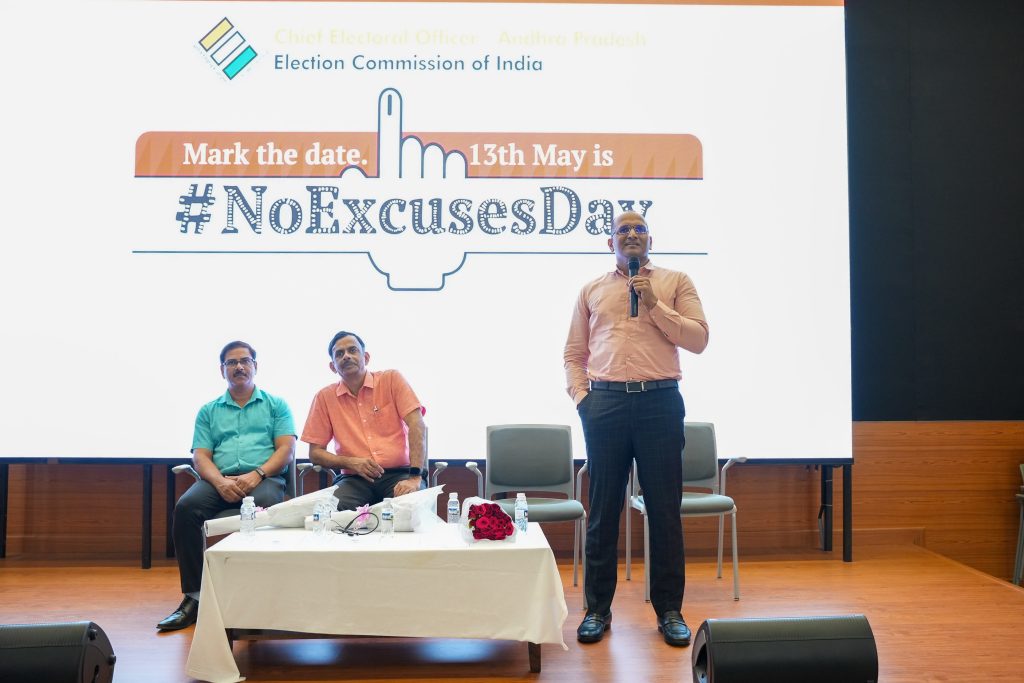
The event reached its pinnacle with the chief guest, Mr Harendhira Prasad’s speech, where the imperative nature of May 13th, termed as “D-day” for both assembly and Lok Sabha elections, was underscored. Stressing the importance of carrying approved identification cards for casting votes, the chief guest reiterated that voting is not just a right but a solemn duty that every citizen must fulfil.
The significance of the None of the Above (NOTA) option was elucidated, serving as a powerful tool for citizens to express dissent and demand accountability from political parties. The chief guest, Mr Harendhira Prasad, made a humble request for citizens to fulfil their duty with the same diligence as those involved in organising the elections, resonating deeply with the audience.
In conclusion, the event served as a poignant reminder of the privileges and responsibilities inherent in a democratic society. Through informative sessions, personal anecdotes, and impassioned speeches, attendees were galvanised to embrace their role in shaping the future of the nation through the simple yet profound act of voting. As May 13, 2024 approaches, the call to action reverberates loud and clear: no excuses, only votes.
- Published in News
Patent Granted for Research in Developing Tarnish Resistant Silver Alloys
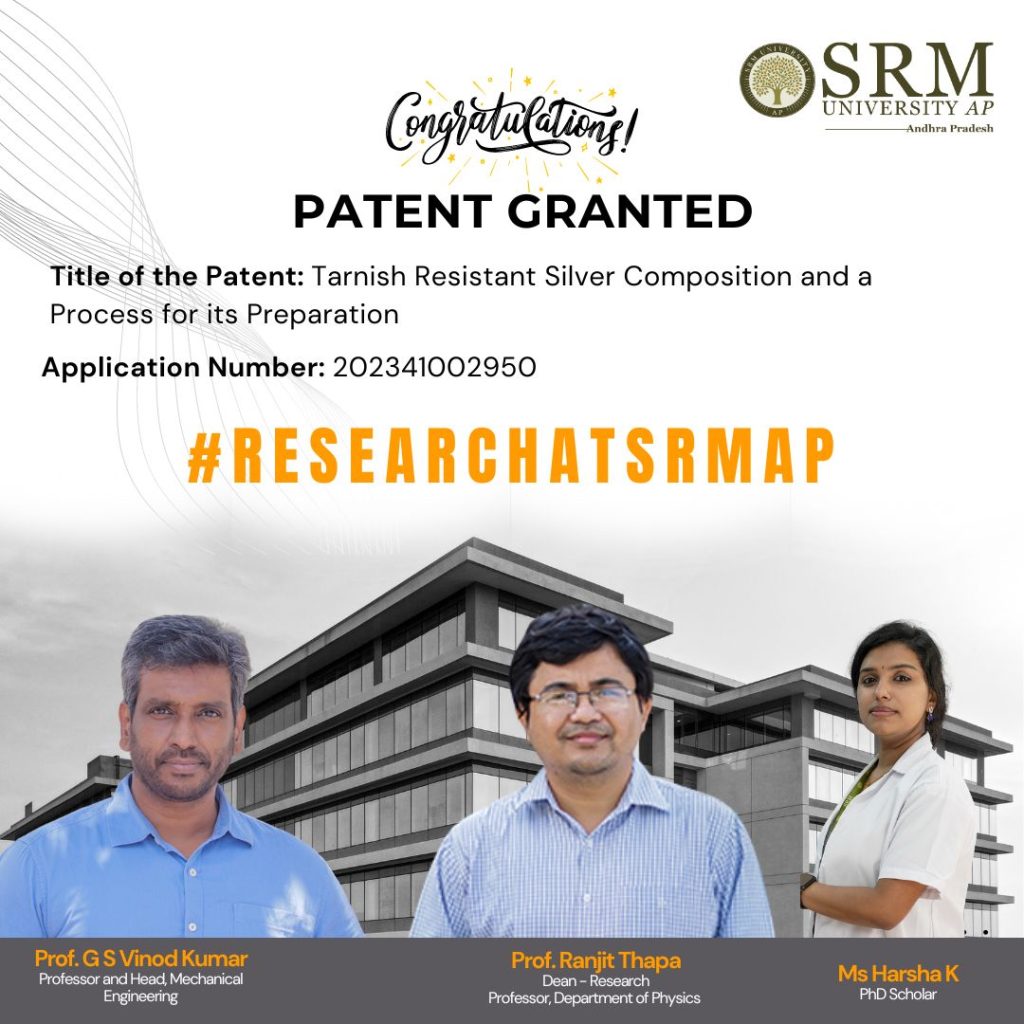
Yet another groundbreaking achievement for the researchers at SRM University-AP! Prof. Ranjit Thapa, Dean-Research and Professor, Department of Physics, Prof. G S Vinod Kumar, Professor and Head, Department of Mechanical Engineering and Ms Harsha K, PhD scholar, continue to make their mark in the university’s excellent research legacy by having their patent “Tarnish Resistant Silver Composition and a Process for its Preparation” being granted by the Indian Patent Office. This innovative research team has used density functional theory to explain the tarnishing of silver. Their work also focuses on finding alloying elements that protect silver.
Abstract
The research is on the development of tarnish-resistant silver alloys from an experimental and computational perspective. With time, silver atoms on the surface of the metal undergo sulphidation and form Ag2S molecules. These particles will accumulate to form a layer whose thickness goes beyond 10nm, and then the human eye will start to find a discolouration on the surface of silver, which is tarnish. The stain colour changes from light yellow to dark brown. This reduces the lustre of silver and makes them aesthetically non-pleasing. The silver jewellery and articles manufacturing industry suffers from this tarnishing as it leads to the loss of material and money and ruins intricate designs made of silver. The research study attempts the problem by alloying silver with appropriate elements, which are computationally checked and verified. The team works with alloying elements such as Cu, Zn, Ge, Ti, Zr, Mg, Al, and Be. Along with tarnish resistance, the proposed alloys maintain high reflectance, good hardness, and excellent workability when spinning.
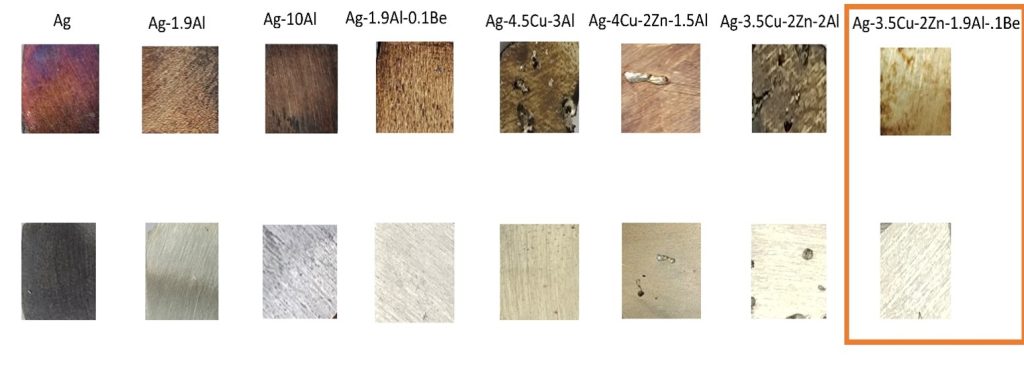
Figure.1 The images of different silver alloys after accelerated tarnish test in as-cast condition (first row) and after undergoing passivation heat treatment at 450°C for 1 hour in the presence of oxygen (second row).
Practical implementation/social implications of the research
- Stainless silver is in demand as customers want their precious metal articles to be kept for a longer time as heirlooms. So, the product that we could develop out of our composition will be making more demand for silver.
- It can increase the market potential of silver.
- It can lead to more innovations in the jewellery industry.
Collaborations
- Waman Hari Pethe
- Ashlyn Chemmannur
- TITAN
The team would continue to work on the scope of research to develop more tarnish-resistant compositions, improve the tensile strength, scratch resistance, surface hardness, and workability of silver alloys and find novel elements which can add to desirable properties of silver.
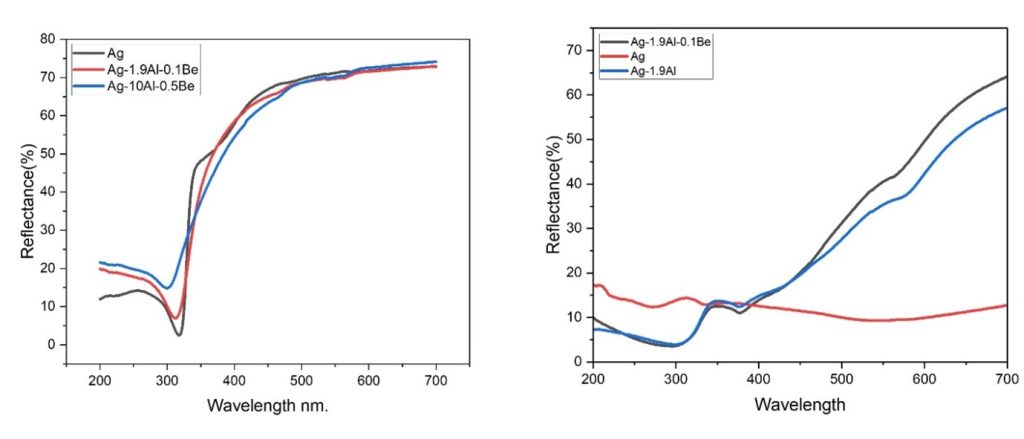
Figure.2 Reflectance of alloys (a) before tarnish test (b) after tarnish test
- Published in Departmental News, Mechanical Engineering NEWS, News, Physics News, Research News
A Review of Non-isolated BDC Topologies for Renewable Energy Systems
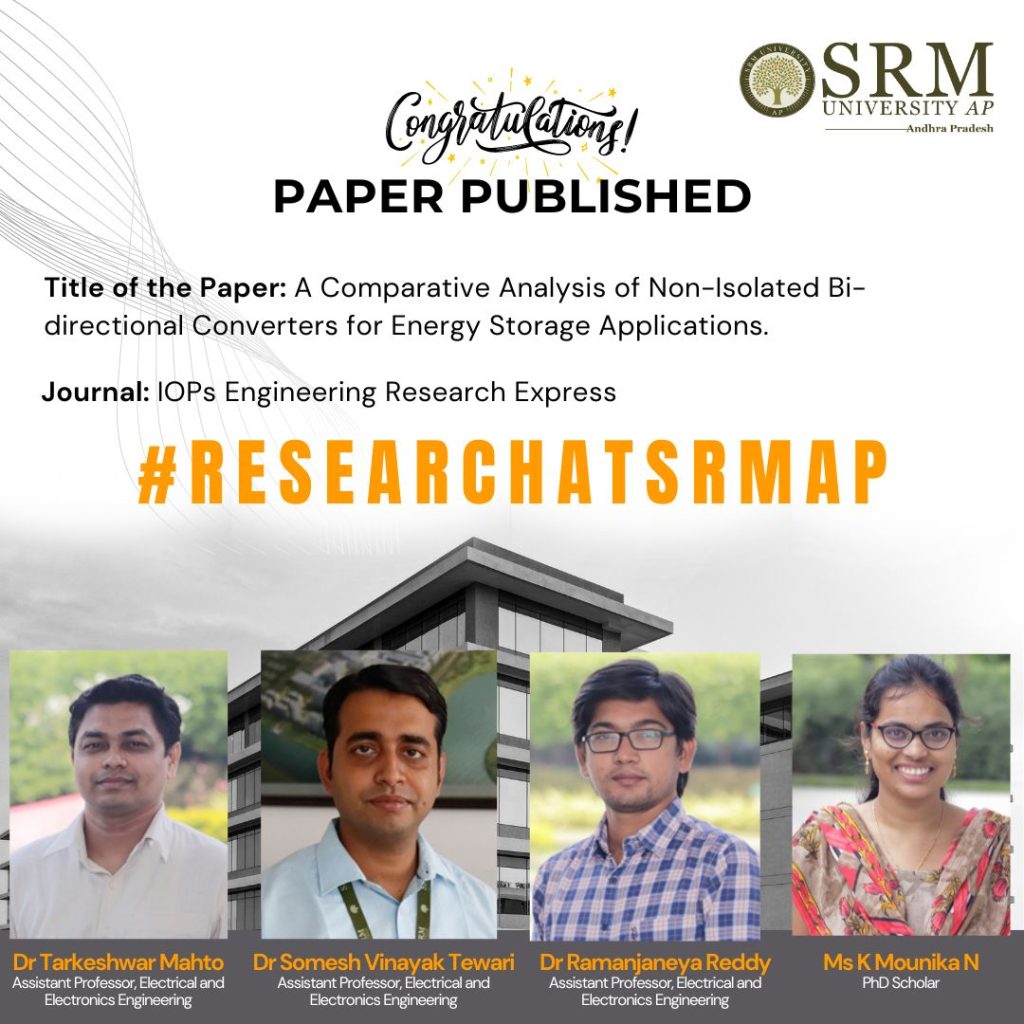
The Department of Electrical and Electronics Engineering is glad to announce that the paper titled “A Comparative Analysis of Non-Isolated Bi-directional Converters for Energy Storage Applications”, authored by Dr Tarkeshwar Mahto, Dr Somesh Vinayak Tewari, Dr Ramanjaneya Reddy, Assistant Professors and Ms K Mounika Nagabushanam, PhD Scholar has been published in the IOPs Engineering Research Express having an impact factor of 1.7. The paper explores various non-isolated bi-directional DC-DC converter topologies for renewable energy systems, providing insights into their performance and suitability for different applications.
Abstract
Bi-directional DC-DC converters (BDC) are required for power flow regulation between storage devices and DC buses in renewable energy-based distributed generation systems. The fundamental requirements of the BDC are simple structure, reduced switching components, a wide range of voltage gain, low voltage stress, high efficiency, and reduced size. There are different BDC topologies for various applications based on the requirements in the literature. Various BDCs are categorised according to their impedance networks. Isolated BDC converters are large due to high-frequency transformers and hence used for static energy storage applications whereas non-isolated BDC is lightweight and suitable for dynamic applications like electric vehicles. This paper reviews types of non-isolated BDC topologies. The performance of five non-isolated BDC converters under steady-state conditions is evaluated using theoretical analysis. On this basis, the suitability of BDC for different applications is discussed. Further advantages and limitations of converters are discussed by using comparative analysis. The optimisation of BDC for distributed generation systems from the perspectives of wide voltage gain, low electromagnetic interference, and low cost with higher efficiency is identified. Theoretical analysis of the converters is validated by simulating 200W converters in MATLAB Simulink.
The main challenges with energy storage systems are frequent failures due to frequent charging and discharging and the volume of the power converter. The team plans to:
- To design a converter with fewer components, low switching stresses, high power transfer capability, and higher efficiency to deliver continuous current to the energy storage system.
- To work on various control techniques to keep the DC link voltage of the propulsion system constant.
Link to the article
- Published in Departmental News, EEE NEWS, News, Research News
A Crash Course in Decoding Language with Ms Andalib Mahmud
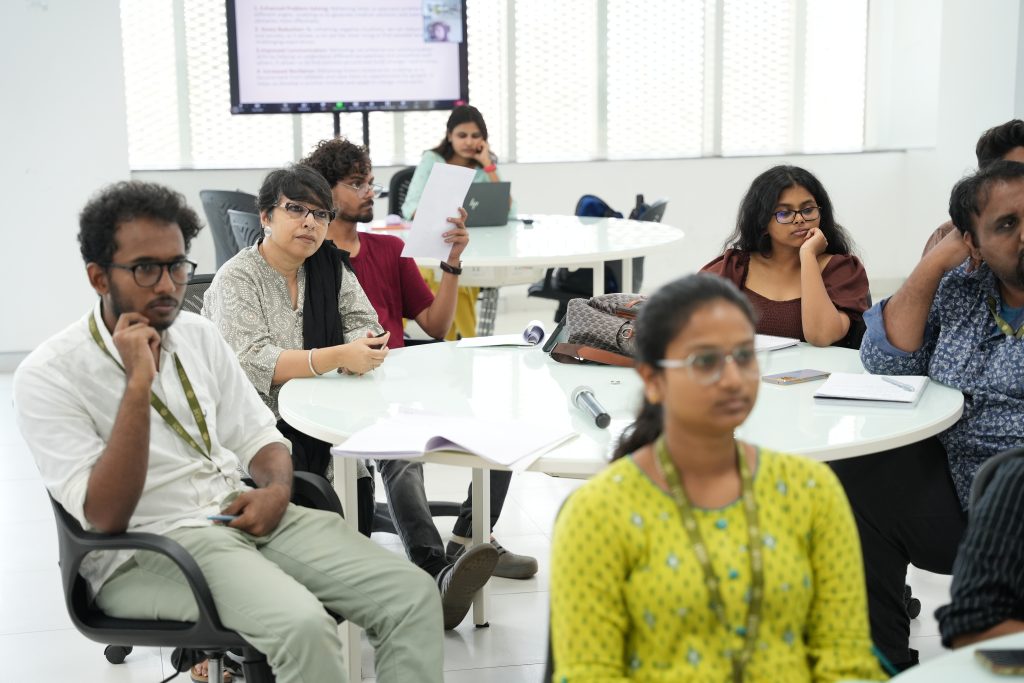
The Department of Literature and Languages invited Ms Andalib Mahmud, distinguished psychologist and master practitioner and trainer of Neuro-Linguistic Programming (NLP), to deliver an insightful guest lecture at SRM University-AP to students enrolled in the open elective course “Decoding Language,” taught by Dr Srabani Basu on May 02, 2024. Ms. Mahmud captivated the audience by elucidating the theory and practice of ‘reframing,’ a behavioural intervention technique utilised in NLP. She expounded on the intricacies of reframing, its techniques, objectives, and efficacy in modifying behaviour patterns. To enhance understanding, Ms Mahmud engaged the students in stimulating group activities, transforming the lecture into an experiential learning session.
The event not only provided students with theoretical knowledge but also offered practical insight into the application of NLP techniques. Ms Mahmud’s expertise and engaging teaching style left a lasting impression on the students, enriching their understanding of language decoding and behavioural interventions. The lecture was a resounding success, inspiring students to delve deeper into the field of NLP and its applications in language and communication.
- Published in Departmental News, English Current Happenings, News
Paaridhan: Weaving a Tapestry of Culture and Ethnicity!
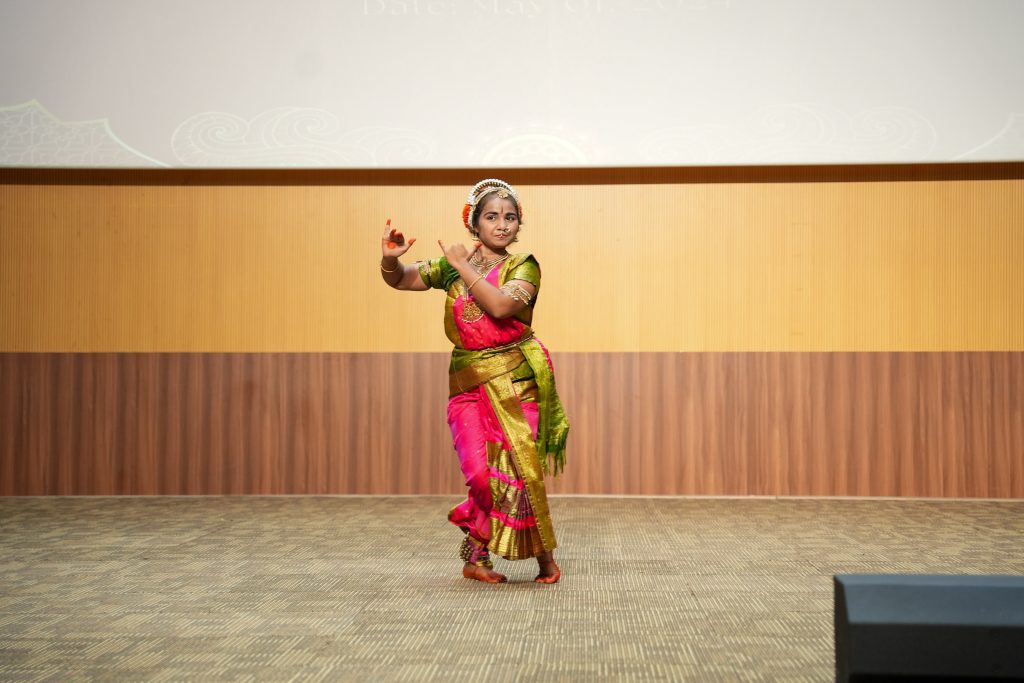
“India is a place where colour is doubly bright. Pinks that scald your eyes, blues you could drown in.” – Kiran Millwood Hargrave
This was a reality at SRM University-AP on May 01, 2024, as the university transformed into a vibrant hub of cultural pride and unity as it celebrated “Paaridhaan”. Students dazzled the campus with an array of performances, fashion walks, and activities, each showcasing the rich tapestry of our diverse backgrounds. The campus was engulfed in a colourful hue as students attended the celebration adorned in traditional ethnic wear.
This remarkable event, organised under the aegis of the Directorate of Student Affairs, included breathtaking dance acts, soulful musical performances, and a fashion show that captivated all in attendance. This celebration brought the university together and left lasting memories of a community united in its diversity.
- Published in Departmental News, News, student affairs news
Enhancing International Placements with Simandhar Education
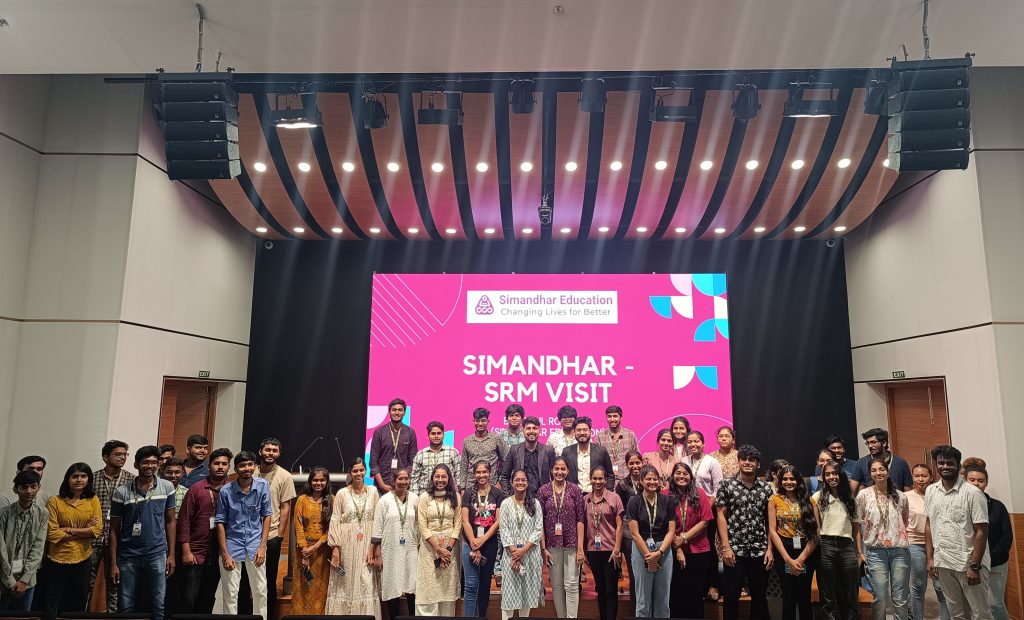
The Paari School of Business has networked with various industry, academia, and social sector partners to ensure that the management and commerce students are placed at national and international firms with lucrative packages. Recently, the school had a visit from Simandhar Education, one of India’s leading institutes providing certified US finance courses in India on April 29, 2024. Mr Rahul Roy and Mr Anupam Biswas, SME from Simandhar Education, shared a comprehensive insight into a potential collaboration between Paari School of Business and Simandhar Education.
Simandhar Education is one of the renowned Indian institutes that provide US CPA/CMA/EA courses. They have 100+ Corporate Tie-ups for training and placement, including with Big 4s and Top 10 global accounting firms. They are the best channel partner of Becker in India, an approved channel partner of AICPA and a Silver approved partner of IMA.
Mr Roy explained the extensive services offered by Simandhar Education in providing quality training and placements for the students of Paari. These include live interactive classes, recorded classes, unlimited practice tests, mock tests, revision lectures, etc. This partnership could be a silver lining for the students of Paari as it enhances their chances of placement in multinational firms in the US.
- Published in Departmental News, News, Paari Current Happenings
Critical Analysis of the Influence of Hydroclimatic Variability and Anthropocene on the Groundwater of the Sundarbans

The water crisis in India, especially in the coastal regions, has worsened alarmingly, coercing environmentalists and researchers to critically study the reason behind this phenomenon. The Sundarbans region faces a scarcity of drinking water in terms of quality and quantity due to various reasons. Dr Kousik Das, Asst. Professor, Department of Environmental Science and Engineering, Dr Harish Puppala, Asst Professor, Department of Civil Engineering and Mr Mijanur Mondal, Research Scholar from the Department of Environmental Science and Engineering has conducted a groundbreaking study on the increased salinization of water due to human activities. The research trio has published a paper titled “Understanding the susceptibility of groundwater of Sundarbans with hydroclimatic variability and anthropogenic influences” in the prestigious Q1 journal Groundwater for Sustainable Development, which has an impact factor of 5.9, critically analysing the numerous factors that affect the quality of drinking water in the Sundarbans region.
Abstract
Coastal aquifers worldwide are experiencing increased salinisation due to climate change and human activities. Sundarbans, in India, is one such area where this phenomenon is noticed at an unprecedented rate, making drinking water unpotable for consumption. Existing studies lack a comprehensive analysis of the underlying causes. This study conducts a systematic literature review to identify drivers of groundwater salinisation, examining climate change parameters such as rainfall patterns, sea level rise, El Niño-Southern Oscillation, and tropical cyclones. Significant groundwater level declines from 1996 to 2017 are primarily attributed to variations in the Indian Ocean Dipole and El Niño Southern Oscillation, affecting rainfall and recharge rates. During tropical cyclones, groundwater levels rise rapidly, and quality is sensitive to El Niño Southern Oscillation. Rising sea levels, changing rainfall, and increasing population density worsen salinisation. Shallow aquifers have high salinity, whereas deep aquifers exceed permissible limits. This underscores the urgent need to address drinking water scarcity and potential migration resulting from complex interactions between climate, population, and groundwater management.
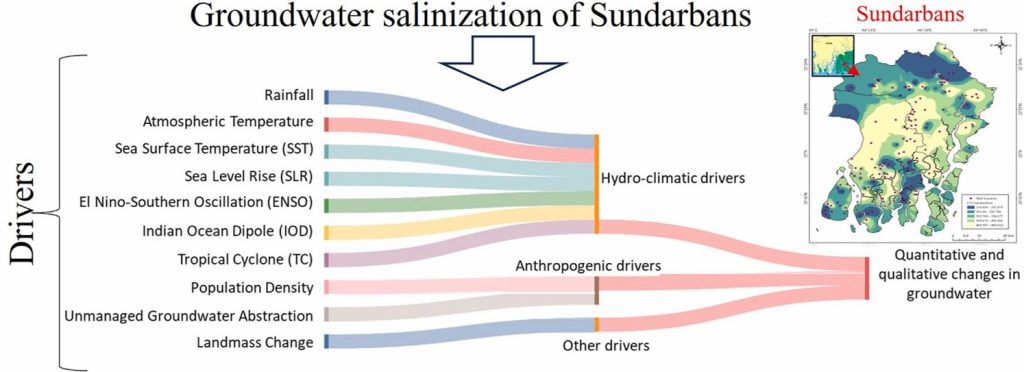
Social Implications of the Research
- Water Quality Monitoring: Implementing regular monitoring of salinity levels in groundwater to ensure compliance with safety standards.
- Community Awareness Programmes: Conducting educational campaigns to inform local communities about the risks of high salinity levels in drinking water and promoting the judicious use of water sources so that unscientific abstraction can be reduced.
- Policy Development: Formulating policies at the local and national levels to regulate salinity levels in drinking water and ensure public health protection.
- Infrastructure Improvement: Investing in water treatment facilities or technologies to remove high salt levels from groundwater sources. Alternative sources and rainwater harvesting can be taken into consideration.
Collaborations – IIT Kharagpur, India
The research team plans to work on Groundwater vulnerability modelling using AI/ML in Sundarbans, India next. The team has begun collecting primary data using questionnaire surveys and interviews to throw light on socio-economic conditions and to understand the core reasons for the water crisis and health and psychological issues due to water unavailability, especially during extreme events like cyclones.
Link to the article
- Published in CIVIL NEWS, Departmental News, ENVS News, News, Research News
Dr Chimoy Das’ Research Makes Latest Breakthrough in Material Science
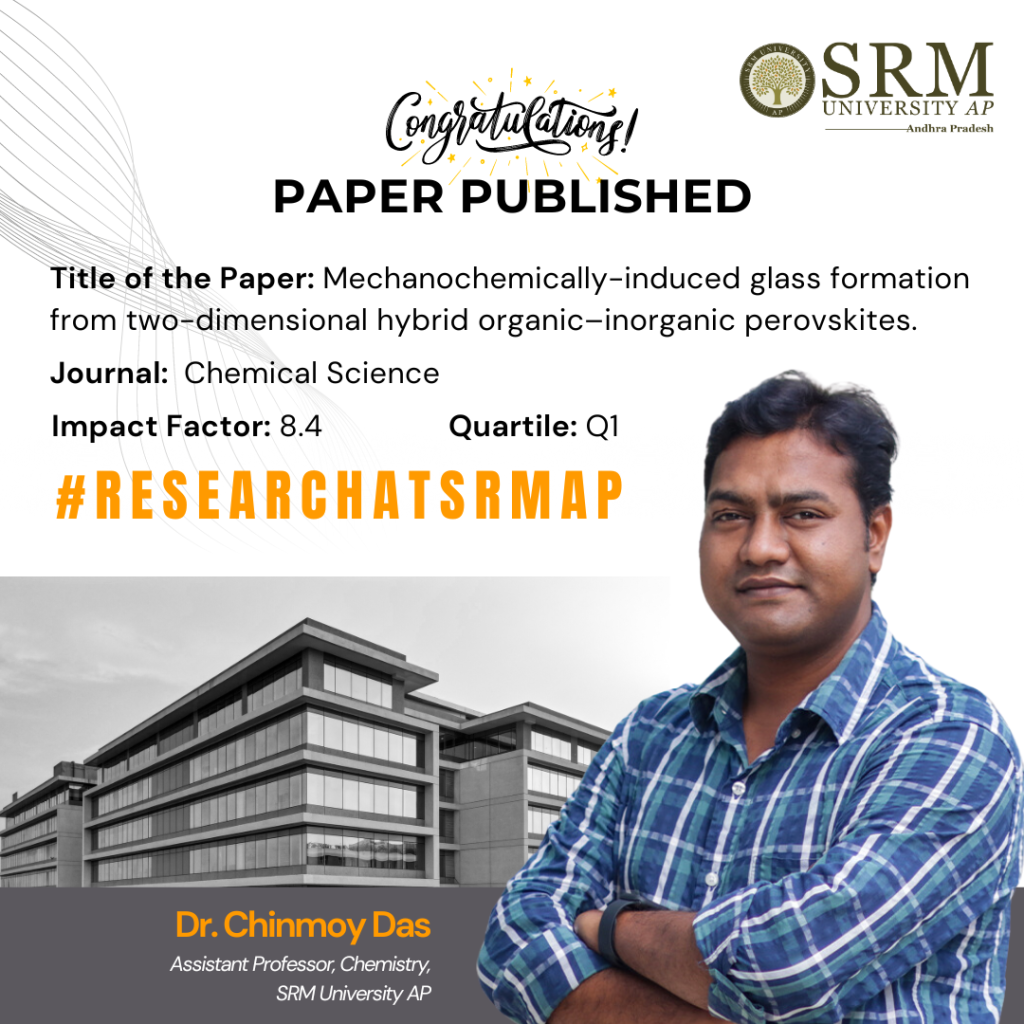
The Department of Chemistry is thrilled to announce the paper “Mechanochemically-induced glass formation from two-dimensional hybrid organic-inorganic perovskites”, published by Dr Chinmoy Das, Assistant Professor in the reputed Q1 Journal Chemical Science with an 8.4 Impact Factor. This groundbreaking research introduces a novel method for transforming crystalline phases into glasses through mechanochemical processes. This environmentally friendly and efficient method opens new doors for manufacturing glasses, revolutionising traditional processes. This remarkable research celebrates this extraordinary blend of chemistry, physics, and innovation!
Abstract
The first mechanochemically-induced hybrid organic-inorganic perovskites (HOIPs) crystal-to-glass transformation was reported as a quick, environmentally friendly, and productive method of making glasses. Within ten minutes of mechanical ball milling, the crystalline phase transformed into the amorphous phase, demonstrating glass transition behaviour as shown by thermal analysis methods. The microstructural evolution of amorphization was studied using time-resolved in situ ball-milling with synchrotron powder diffraction. The results indicated that energy may accumulate as crystal defects because the crystallite size reaches a comminution limit before the amorphization process is finished. The limited short-range order of amorphous HOIPs was discovered through total scattering experiments, and photoluminescence (PL) and ultraviolet-visible (UV-vis) spectroscopy were used to examine their optical characteristics.
Explanation of the research in layperson’s terms
Crystalline inorganic perovskites (general chemical formula is ABX3, where A and B are cations, and X is anion) are generally known for their unique optoelectronic applications, such as solar cells, photodetectors, and LEDs (light emitting diodes). In this research, Dr Das revealed hybrid materials comprised of organic linkers and inorganic nodes, which constitute hybrid organic-inorganic perovskites (HOIPs). The research demonstrated a rapid and environment-friendly (mechanochemically ball milling assisted) synthetic approach to transform the crystalline phase to its non-crystalline/amorphous phase. Interestingly, the amorphous phase of HOIPs showed temperature-dependent glass transition temperature (Tg) at very low temperatures, ~50 C. The structure of the HOIP glasses has been characterised through total-X-ray diffraction studies and pair-distribution functions. The crystalline and glassy HOIPs showed optical properties, which were studied by photoluminescence (PL) and ultraviolet-visible (UV-vis) spectroscopy.
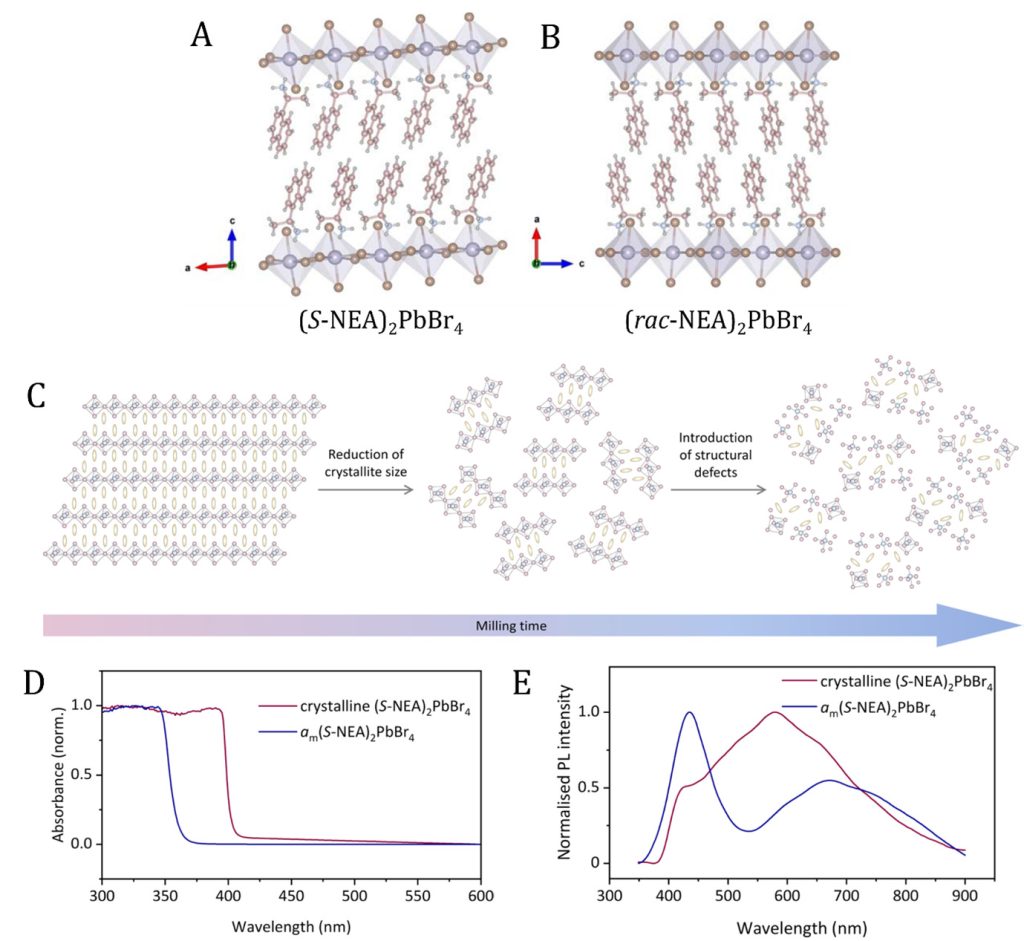
Figure 1. Single crystal structures of (A) (S-NEA)2PbBr4 and (B) (rac-NEA)2PbBr4. Pb, Br, C, N and H atoms are represented by purple, brown, pink, blue, and grey colours, respectively. (C) Schematic illustration of the microstructural evolution on 2D HOIPs upon ball-milling. (D) UV-Vis and (E) photoluminescent properties of crystalline (S-NEA)2PbBr4 (purple) and glassy (S-NEA)2PbBr4 (blue) HOIPs.
Practical implementation/ social implications of your research
Through the mechanochemical approach, we prepared novel hybrid organic-inorganic perovskite (HOIP) glasses within ten minutes, showing the greater feasibility of processing the glass material for industrial implication. On the other hand, we also demonstrated that the HOIP glasses showed photoluminescence properties, which would enable us to fabricate the device for solar cells, photodetectors, LEDs and many more.
Collaborations
- Department of Materials Science and Metallurgy, University of Cambridge, United Kingdom.
The Department of Chemistry has established a research group at SRM University-AP, and the group has started to explore an emergent research area of crystal-glass composite materials towards the applications of atmospheric water harvesting, solid-state electrolytes, photovoltaics, and conversion of gaseous Carbon-dioxide molecules to industrially relevant liquids, such as methanol or ethanol.
Any interested candidate can reach out to Dr Chinmoy for exciting projects.
- Published in Chemistry-news, Departmental News, News, Research News
Field Visit: Biological Sciences Students at AIIMS Mangalagiri
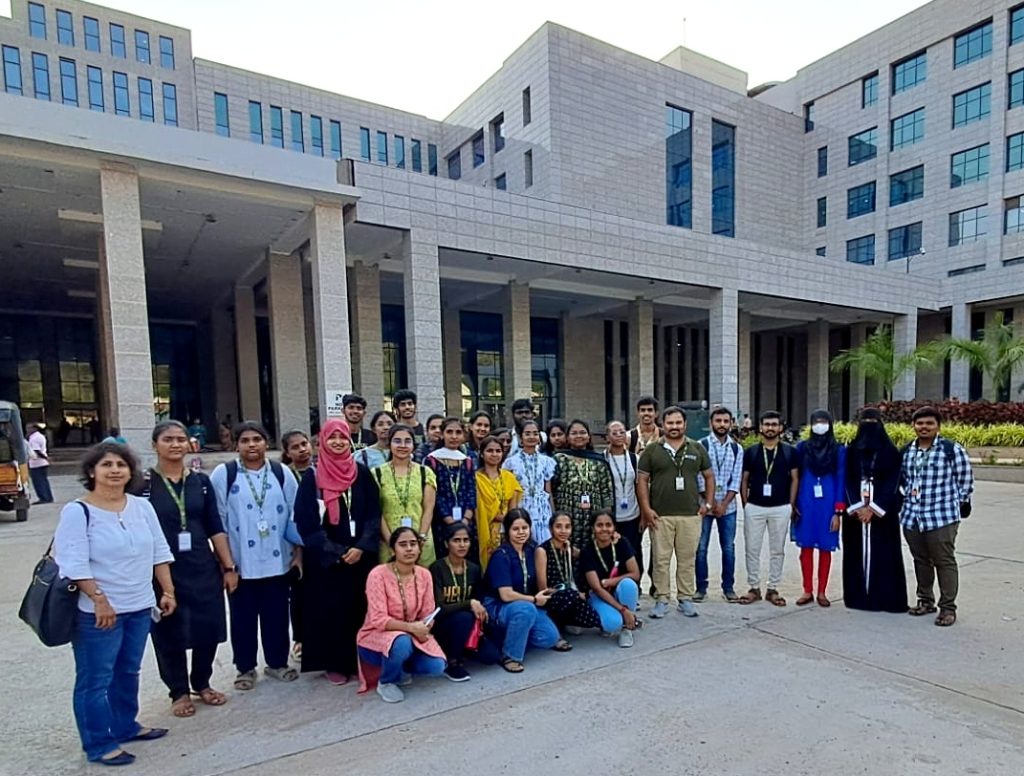
In a significant stride towards enriching their academic experience, students from the Department of Biological Sciences embarked on a captivating field trip to AIIMS Mangalagiri. This excursion served as an integral component of their Active Learning Process, fostering a deeper understanding of real-world applications in the realm of biology. The cohort comprised students from diverse academic backgrounds, including those pursuing 1st year B.Sc in Integrative Biology and M.Sc in Molecular Biology & Biotechnology. Their visit to AIIMS Mangalagiri provided them with a unique opportunity to gain firsthand insights into cutting-edge practices in the field of biomedicine.
During their visit, the students were granted exclusive access to the Integrated Stewardship and OPD Labs, where they were immersed in a world of advanced diagnostics and research methodologies. Expert lectures and demonstrations on state-of-the-art diagnostic techniques such as MALDI-TOF, CBNAAT, CLIA, Vitek, and BactAlert offered invaluable insights into the intricacies of disease detection and monitoring.
This excursion underscored the department’s commitment to fostering a culture of active learning and practical exposure among its students. By exposing them to prominent institutions and industries, such as AIIMS Mangalagiri, students were provided with hands-on training and the opportunity to engage with leading experts in the field.
Accompanying the students were esteemed faculty members of the department, including Dr Sutharsan Govindarajan, Dr Sudeshna Saha, and Dr Prateek Gupta, whose guidance and mentorship further enriched the learning experience.
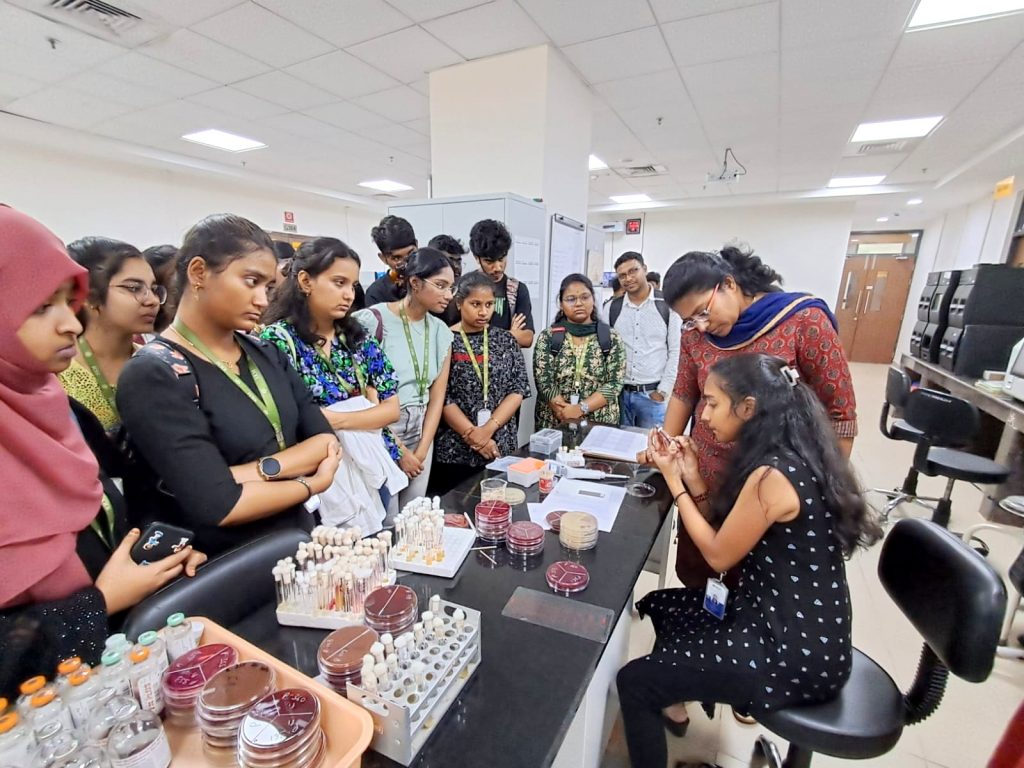
Furthermore, the collaborative efforts between the faculty of SRM University-AP and researchers at AIIMS Mangalagiri were highlighted during the visit. These collaborations span various domains, from developing biomedical devices for disease diagnosis to research endeavours in antimicrobial resistance (AMR), early cancer detection, and drug targeting. Such synergies between academia and research institutions present students with unparalleled opportunities to engage in impactful research initiatives and contribute meaningfully to the advancement of scientific knowledge
Overall, the field visit to AIIMS Mangalagiri served as a catalyst for academic excellence and professional growth, empowering students with the skills, knowledge, and networks necessary to thrive in the dynamic field of biological sciences.
- Published in Biology News, Departmental News, News
Creating History: A Chase to Mt. Everest!
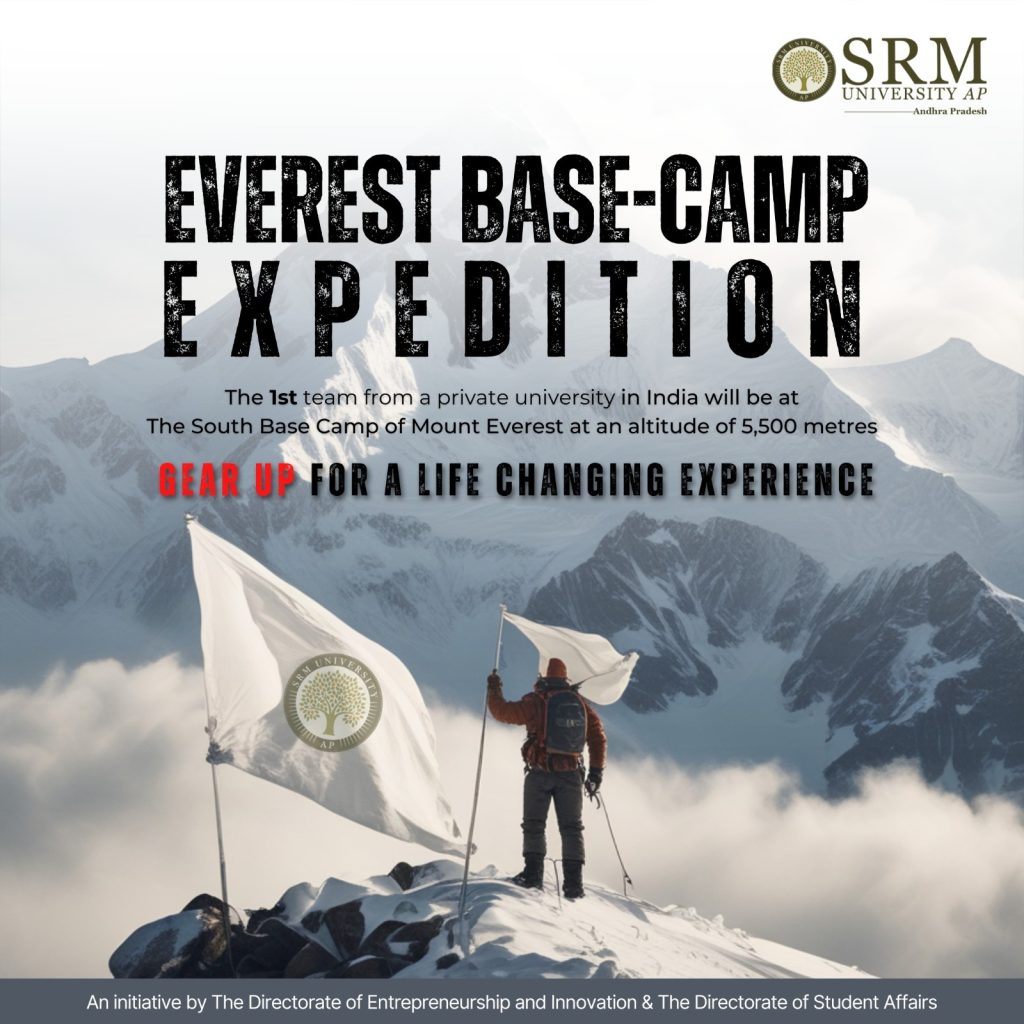
SRM University-AP is gearing up for the ultimate thrill-seeking escapade, which will have hearts racing and adrenaline pumping like never before! The Directorate of Entrepreneurship & Innovation and the Directorate of Student Affairs jointly organise the “Everest Base Camp Expedition”, the mother of all adventures – a daring conquest of the Earth’s highest mountain above sea level – Mount Everest!
The 15-day exhilarating journey will take flight with a maiden batch of 20 young adventurers selected through a rigorous physical and mental ability test on October 11, 2024 (tentative). 4 months of extensive training will commence in full swing, with the selected students pushing their limits and testing their endurance, moulding them into a complete voyager. Various training and practice trips have been scheduled to Arakku Valley to test their strength, Mangalagiri temple for elevation trekking training and much more.
This is a first-of-its-kind initiative by a university in India, presenting a unique opportunity for every enthusiastic explorer to witness the magnificence of the cold, icy peaks of the Himalayas. In addition to providing students with exemplary academic, research and entrepreneurial resources, SRM AP also emphasises the significance of 21st-century skills in nurturing them into socially aware and ethical citizens of tomorrow. This one-of-a-kind trip will ensure that students imbibe the value of belief and courage to instil purpose or a greater aim for anything that they might pursue in life, the importance of not losing faith during hard times and overcoming the obstacles that hinder your aim, the significance of camaraderie and teamwork, to develop essential leadership skills etc.
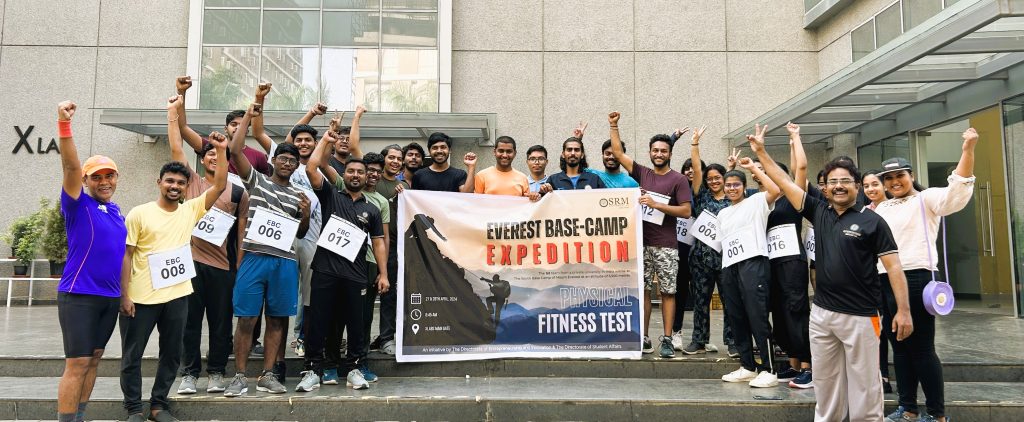
Students and their mentors have already begun their footsteps on a journey that will transform their lives! Embracing the thrill, embracing the adventure!
This journey will undoubtedly etch unforgettable memories into the fabric of their existence!
- Published in Departmental News, IDEA NEWS, News, student affairs news


